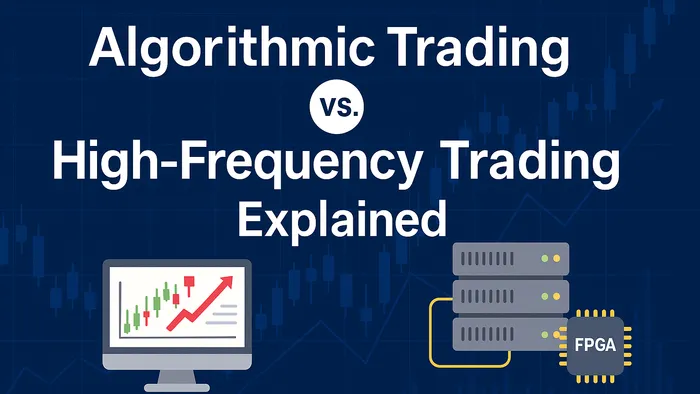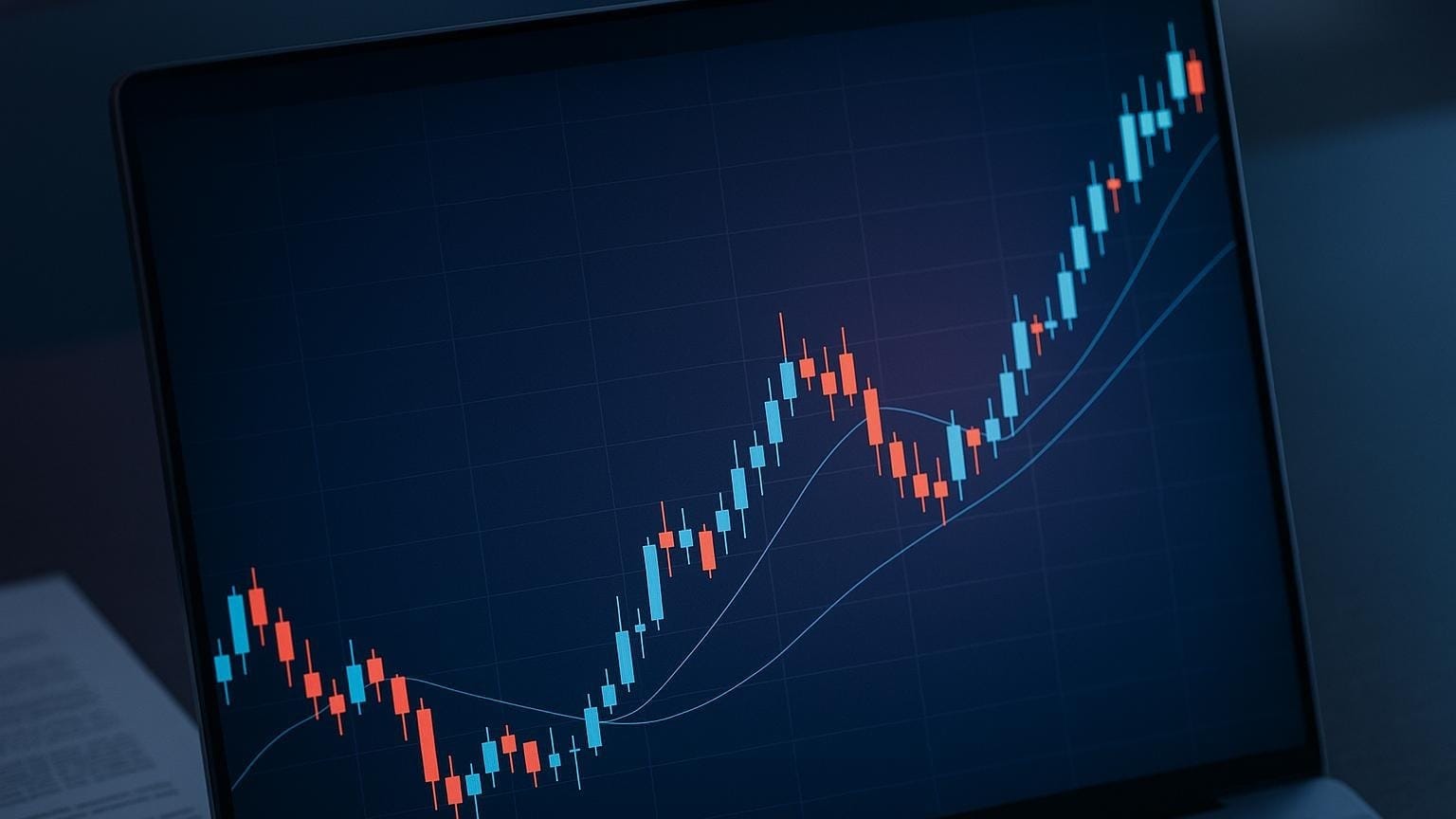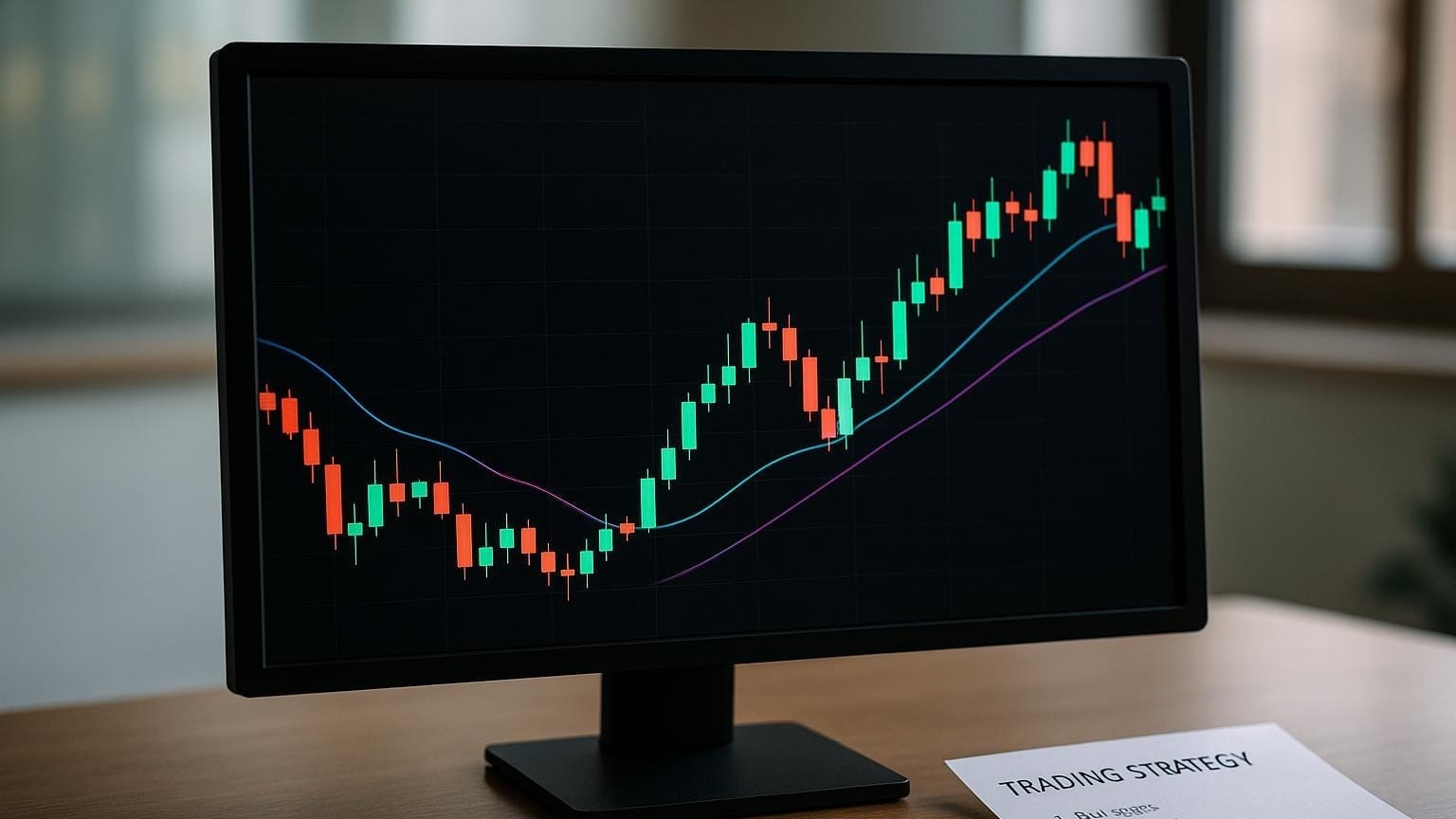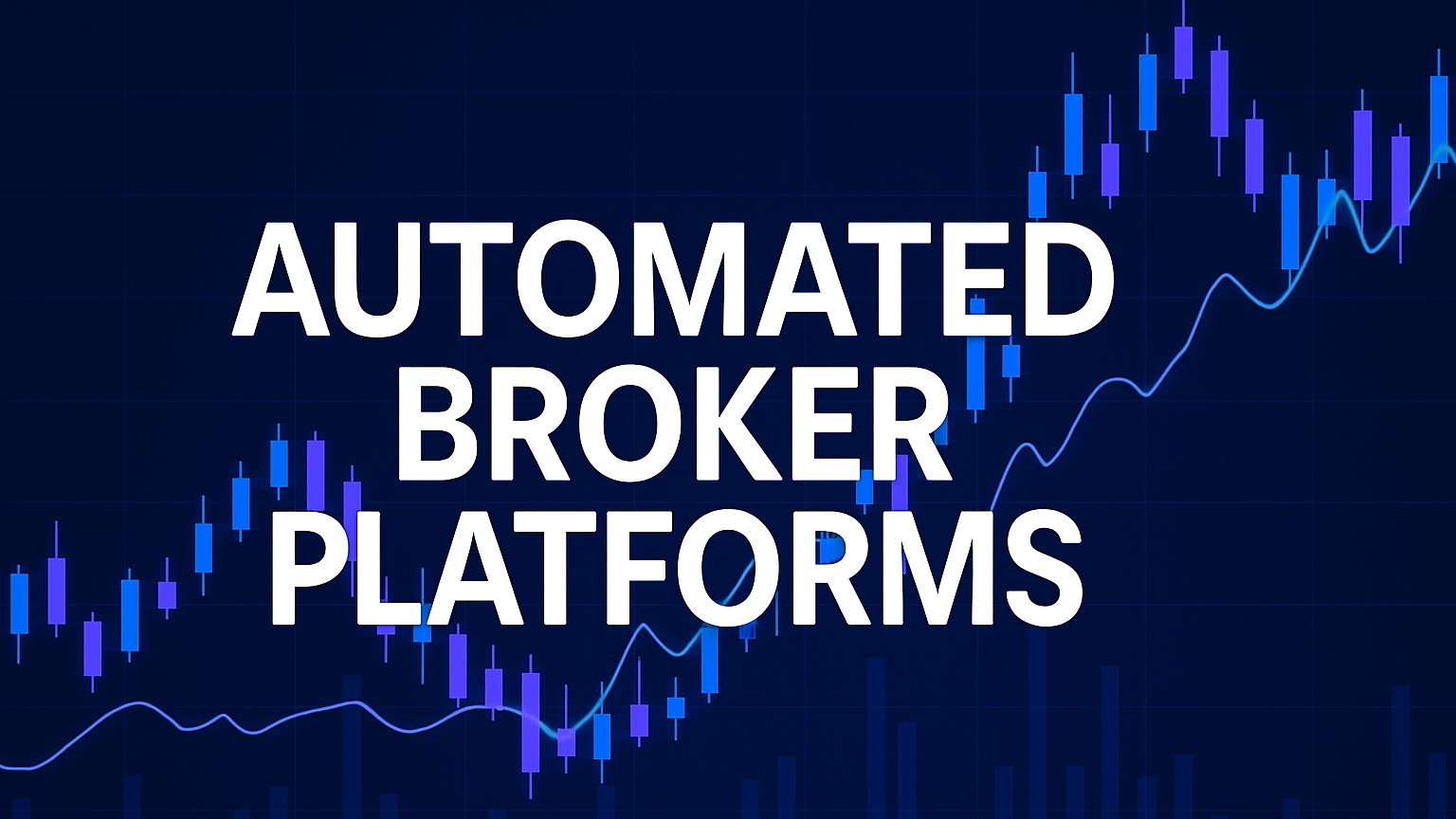Explore the key differences between high-frequency trading and retail algorithmic trading, including speed, costs, and strategies.
High-frequency trading (HFT) and retail algorithmic trading are two distinct approaches to automated trading. Here's a quick breakdown:
- HFT: Used by institutions, executes trades in microseconds, requires advanced infrastructure like co-location and direct market access, and focuses on strategies like arbitrage and market making.
- Retail Algorithmic Trading: Accessible to individual traders, uses simpler setups (e.g., a standard PC), operates on longer timeframes, and focuses on trend-following or momentum strategies.
Quick Comparison
| Feature | High-Frequency Trading (HFT) | Retail Algorithmic Trading |
|---|---|---|
| Users | Institutions, banks | Individual traders |
| Speed | Microseconds | Milliseconds to seconds |
| Cost | High (millions) | Low ($5,000-$20,000) |
| Infrastructure | Advanced (co-location, FPGA) | Standard PC or VPS |
| Strategies | Arbitrage, market making | Trend following, swing trading |
| Market Access | Direct exchange feeds | Public data feeds |
HFT is ideal for institutions with significant resources and expertise, while retail algorithmic trading suits individual traders aiming for affordability and simplicity.
Navigating Markets: Algorithmic Trading vs. High-Frequency Trading Explained
Speed and Technology Requirements
This section dives into the key differences in speed and technology between high-frequency trading (HFT) and retail algorithmic trading.
HFT Infrastructure and Speed
High-frequency trading relies on systems designed to minimize latency as much as possible. These systems execute trades in as little as 0.01 microseconds. To achieve this, they require highly specialized setups, including:
- Co-location services to place servers near exchange facilities.
- FPGA (Field Programmable Gate Array) units for faster processing.
- Direct market access for immediate trade execution.
- Ultra-low latency connections, operating in the range of 300-800 nanoseconds.
For example, the London Stock Exchange's Millennium Exchange platform operates with an average latency of 126 microseconds, but ultra-low latency systems can complete round-trip executions in under 10 milliseconds.
Retail Trading Platforms
Retail algorithmic trading, on the other hand, focuses on ease of use and reliability rather than microsecond-level speed. These platforms are built on more accessible technology and tools, such as:
| Platform Feature | Typical Specifications |
|---|---|
| Hardware Requirements | A standard computer with a stable internet connection |
| Programming Languages | Python is a popular choice for strategy development |
| Data Feeds | Publicly available market data streams |
| Execution Speed | Ranges from milliseconds to seconds |
| Risk Management | Built-in tools provided by the platform |
The retail algorithmic trading market was valued at $2.03 billion in 2022 and is expected to grow to $3.56 billion by 2030.
Speed and Tech Comparison
The gap between HFT and retail algorithmic trading is stark, particularly in terms of execution speed and infrastructure:
| Aspect | HFT Systems | Retail Algo Systems |
|---|---|---|
| Processing Speed | Nanoseconds | Milliseconds to seconds |
| Infrastructure Cost | Millions of dollars | Thousands of dollars |
| Market Data Access | Direct exchange feeds | Publicly available feeds |
| Algorithm Complexity | Optimized C++ code | Various programming languages |
| Location Requirements | Co-location near exchanges | Standard internet connection |
"HFT requires a very sophisticated and advanced infrastructure to bear the high speed and competition that comes with trading in the current market setting." - BlueChipAlgos.com
A real-world example highlights this disparity: HFT firms use C++ to create arbitrage algorithms capable of identifying price differences and executing trades within microseconds. These systems rely on pre-loaded data and highly optimized routes. In contrast, retail traders must account for slower execution speeds and adopt different strategies to remain competitive.
Next, we’ll explore how these technological differences affect costs and market entry.
Cost and Market Entry

This section highlights the cost differences and challenges of entering the market for high-frequency trading (HFT) compared to retail algorithmic trading.
HFT Setup Costs
Launching an HFT operation involves substantial expenses:
HFT setups demand premium data feeds ($5,000 to $50,000+ per month), high-performance servers (starting at $20,000), colocation services ($8,000 per month), custom software (up to $1 million), and specialized personnel with base salaries starting at $150,000 per year.
Breakdown of software costs:
- Off-the-shelf solutions: $10,000 to $20,000 per month
- Custom-built systems: Can exceed $1 million upfront
- Maintenance and updates: Add 15-20% of the initial cost annually
Retail Trading Costs
Retail algorithmic trading is far more affordable:
| Cost Component | Typical Range | Notes |
|---|---|---|
| Platform Fees | $0 - $200/month | Depends on the provider |
| Trading Commissions | $0 - $20/trade | Many platforms offer commission-free trading |
| Data Subscriptions | Included - $150/month | Basic market data often free |
| Hardware | $1,000 - $3,000 | Standard computer setup |
Platforms like TradeStation offer commission-free trading for stocks, options, and futures. Similarly, MetaTrader 4 provides free access, with users only paying broker spreads or commissions.
Cost Comparison Table
| Aspect | HFT Requirements | Retail Algo Trading |
|---|---|---|
| Initial Capital | $250,000+ | $5,000 - $20,000 |
| Infrastructure | $20,000+ (servers) $8,000+/month (colocation) |
Personal computer or VPS |
| Market Data | $5,000 - $50,000+/month | Often included with platform |
| Software | $10,000 - $20,000+/month | $0 - $200/month |
| Personnel | $150,000+/year/person | Individual trader |
"For HFT it will be a few hundred thousand dollars which you will be spending on acquiring the required infrastructure and platform. That is why the cost will be higher." - Nitesh Khandelwal, Co-founder and CEO of QuantInsti
While most HFT ventures require significant capital, some firms manage to start with as little as $20,000.
Trading Methods and Timeframes
Trading methods and timeframes play a key role in differentiating high-frequency trading (HFT) from retail algorithmic strategies.
HFT Methods
HFT operates at lightning-fast speeds, executing trades in microseconds to milliseconds. In the U.S., the average holding time for stocks in HFT is just 22 seconds. Common HFT methods include:
- Market Making: Continuously quoting buy and sell prices.
- Statistical Arbitrage: Taking advantage of short-lived price differences.
- Order Flow Prediction: Analyzing market patterns for rapid trade execution.
For perspective, the Nasdaq TotalView ITCH feed produces over 20 gigabytes of data daily, with peaks reaching 3 megabytes per second.
Retail Trading Methods
Retail algorithmic traders, on the other hand, work with longer timeframes and prioritize strategies that are effective over extended periods rather than focusing on speed. They often rely on higher timeframe charts, where trends and market inefficiencies are easier to spot.
| Timeframe | Common Uses | Recommended For |
|---|---|---|
| 4-hour | Trend following, swing trading | Beginners, part-time traders |
| 1-hour | Day trading, momentum strategies | Intermediate traders |
| 15-minute | Breakout trading | Advanced traders |
Retail traders are generally advised to avoid timeframes shorter than 5-minute candles.
Common Strategy Examples
The strategies used in HFT differ significantly from those in retail algorithmic trading:
| Strategy Type | HFT Implementation | Retail Algorithmic Implementation |
|---|---|---|
| Market Making | Continuous quotes at microsecond intervals | Not practical for most retail traders |
| Arbitrage | Exploits millisecond-long cross-exchange price differences | Uses statistical arbitrage over longer periods |
| Trend Following | Rarely used due to short holding times | Applied using higher timeframe charts (e.g., 1-hour or 4-hour) |
| Volume Analysis | Analyzes tick-level order flow | Relies on aggregated volume indicators |
Retail traders should stick to 1-hour or 4-hour charts, leverage automated execution tools with manual oversight, and focus on identifying inefficiencies over longer periods.
In U.S. markets, computer algorithms are responsible for more than one-third of all orders.
Rules and Market Effects
HFT Regulations
High-frequency trading (HFT) is now subject to tighter scrutiny. The SEC has updated its definition of dealers, focusing on trading behaviors, particularly those showing interest near the best available prices on both sides of the market.
Firms involved in HFT and registered with FINRA must adhere to a range of rules, including:
- SEC requirements for capital and disclosures
- Anti-manipulation rules
- FINRA Rule 3110, which mandates oversight of algorithmic trading activities
"High-frequency trading firms using lightning-fast computer technology have begun to dominate our markets... their trading patterns aren't always fair to investors and they can be primary contributors to huge market price swings and even crashes." - Benjamin Schiffrin, Director of Securities Policy, Better Markets
Retail Trading Rules
Retail algorithmic traders must meet strict standards for investor protection and market stability. These include:
| Aspect | Regulatory Focus | Impact on Traders |
|---|---|---|
| Testing | Validating strategies pre-launch | Ensures strategies are tested before use |
| Monitoring | Reviewing performance post-launch | Ongoing risk and performance checks |
| Compliance | Communicating with regulators | Requires clear documentation |
| Risk Management | Overseeing risks across disciplines | Enforces strong risk controls |
Market Impact Analysis
HFT and retail algorithms influence markets in distinct ways. HFT currently makes up about 50% of U.S. equity trading volume and 50% of U.S. Treasury trading volume.
Some key effects include:
- Short-term Volatility: HFT increases intraday volatility by 30%.
- Faster Information Processing: Stocks with heavy HFT activity process new data 1.5 times faster.
- Liquidity Challenges: During market stress, HFT liquidity drops by 40%.
The 2010 Flash Crash is a stark example of HFT's impact. In just 14 seconds, 27,000 contracts were traded (49% of volume), while E-Mini buyers fell to $58 million.
"The use of these qualitative standards to regulate dealers will confer significant benefits in terms of investor protection, market stability, transparency, oversight, and fairness." - Better Markets
"I can see a world where seemingly 'rational' AI, unconstrained and exposed to certain markets and data, would deem it entirely rational to commit market manipulation. Now, the FCA cannot prosecute a computer, but we can seek to prosecute the people who provided the governance over that computer."
These evolving regulations and market trends are directly shaping trading strategies.
Making Your Choice
Use the comparisons below to decide which trading style aligns best with your goals.
Key Decision Differentiators
| Feature | High-Frequency Trading (HFT) | Retail Algorithmic Trading |
|---|---|---|
| Execution Speed | Microseconds | Longer timeframes |
| Technology | Co-location required | Standard platforms |
| Capital Needs | High | Moderate |
| Expertise | Price Action Concepts market structures knowledge | Basic programming skills |
| Market Focus | Short-term arbitrage | Long-term strategies |
| Accessibility | Institutional | Individual traders |
Advantages and Disadvantages
High-Frequency Trading
- Advantages:
- Lightning-fast execution
- Enhances market liquidity
- Advanced risk management tools
- Strong pattern recognition systems
- Disadvantages:
- Requires significant capital
- Faces strict regulatory scrutiny
Retail Algorithmic Trading
- Advantages:
- Lower barriers to entry
- Flexible strategy options
- Automates decision-making processes
- Open to a wider range of traders
- Disadvantages:
- Slower execution compared to HFT
- Demands programming knowledge
- Navigating market complexities can be challenging
Weigh these factors carefully when deciding which approach aligns with your trading goals.
Decision Factors
Your choice will depend on three main aspects: capital, technical expertise, and time horizon.
- Capital Resources: HFT requires a hefty investment, while retail algorithmic trading is more accessible with smaller capital.
- Technical Expertise: HFT calls for deep knowledge of market microstructure and low-latency systems. Retail algorithmic trading only requires basic programming and quantitative skills.
- Time Horizon: HFT is ideal for microsecond-level trades if you have the resources and skills. Retail algorithmic trading suits strategies that span from minutes to months.
For most individual traders, retail algorithmic trading is a more practical option. With the global algorithmic trading market valued at $2.03 billion in 2022 and expected to grow to $3.56 billion by 2030, this space offers plenty of opportunities for growth and participation.








